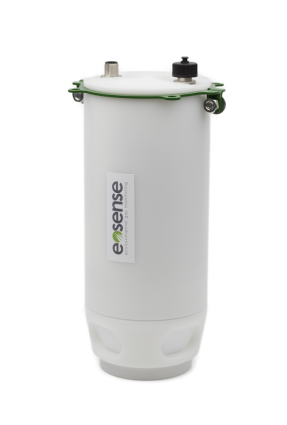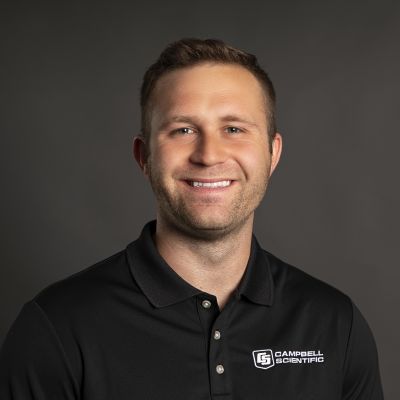Soil CO2 Flux Measurements Made Easy
by Robin Deissinger | Updated: 06/24/2019 | Comments: 0

Patented technology enables a new sensor to measure soil CO2 flux directly, providing you with new flexibility to make your measurements. In this interview, Hayden Mahan, Gas Flux and Turbulence Product Manager, introduces us to the eosFD and explains how this sensor works. Hayden was interviewed by Robin Deissinger, the blog editor.

Interview Q&A
What is the eosFD?
The Eosense Forced Diffusion (eosFD) sensor is revolutionary. It’s a soil CO2 flux sensor that uses patented Forced Diffusion technology to measure soil gas flux directly. Forced Diffusion is a membrane-based steady-state approach to measure gas flux. It establishes an equilibrium between gas flowing into the chamber and gas flowing out of the chamber through the membrane—without any external movement.
The diffusive properties of the membrane used in the instruments are carefully characterized, then the eosFD chamber gas concentration is correlated directly to the gas flux rate. Basically, if you take the amount by which this membrane limits the flow of gas out of the chamber, and you compare the internal concentration to that outside the instrument, you can calculate the flux rate. Well, the eosFD does this calculation automatically for you.
Why is measuring the flux rate important?
Soil respiration is a large contributor to the overall carbon budget, and being able to measure soil CO2 flux is important in eddy-covariance research. The eosFD is a stand-alone sensor that collects high-resolution flux data directly, but you can also pair it with a Campbell Scientific eddy-covariance system. This gives you more detailed insight into the role that the soil surface has in the carbon cycle of an ecosystem.
Why are you excited about the eosFD?
This is a completely stand-alone chamber that requires less than 1.6 watts of power, meaning that you can deploy an array that spans anywhere from meters to kilometers of spatial coverage. There are endless possibilities for research. This product is easy to use, lightweight, and installation time takes just a few minutes. This sensor is ideal for integrating into Campbell Scientific eddy-covariance systems, whether it’s just one eosFD being deployed or many.
What makes the eosFD different from other products?
No other sensor uses the patented Forced Diffusion technology. Unlike other automated chambers that lift and lower onto the soil surface, the Forced Diffusion approach doesn’t require external moving parts. This means you can deploy it in the harshest climates for extended periods—unattended. This technology requires little power, less than 1.6 watts. It also reports high-resolution fluxes directly without the need for any post-processing. The eosFD is compact, which reduces the environmental interference that can be a problem for larger soil chamber instruments. This sensor is truly stand-alone; internal data storage enables this sensor to record up to 65,000 measurements.
How is the eosFD used with other products in a system?
Because a large portion of ecosystem CO2 respiration comes from the soil surface, it is important to make two types of measurements: at the soil surface and above canopy eddy-covariance measurements. Not only can you use this sensor in a stand-alone application, but you can easily use it with a Campbell Scientific eddy-covariance system. With analog and serial output capabilities, this sensor can send data to a Campbell Scientific data logger. Your data can seamlessly integrate with the EasyFlux® DL CRBasic program for data synchronization with your other flux and environmental measurements. You can even view your data from the eosFD in real time with Campbell Scientific’s EasyFlux® Web software.
Is the eosFD available now?
Yes. The eosFD is available for purchase. Contact a Campbell Scientific employee for a quote.
More Information
Do you want to learn more about the eosFD? Please visit the eosFD Soil CO2 Flux Sensor web page.
To ask Hayden a question about the eosFD, post a comment below.
















 Robin Deissinger is the Web Content Specialist at Campbell Scientific, Inc. She creates and maintains content on the company website, which is then shared across the global websites. She also manages a corporate website development project. Previously, Robin was responsible for the corporate social media program and wrote blog articles. Robin graduated from Bradley University with a bachelor's degree in communications with an emphasis in advertising, as well as a minor in psychology.
Robin Deissinger is the Web Content Specialist at Campbell Scientific, Inc. She creates and maintains content on the company website, which is then shared across the global websites. She also manages a corporate website development project. Previously, Robin was responsible for the corporate social media program and wrote blog articles. Robin graduated from Bradley University with a bachelor's degree in communications with an emphasis in advertising, as well as a minor in psychology.
Comments
Please log in or register to comment.